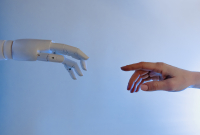Support strong Canadian climate journalism for 2025
Artificial intelligence (AI) is a captivating frontier that holds immense excitement and promise. It's a realm where machines learn, adapt and innovate, reshaping industries and enhancing our daily lives. From self-driving cars to advanced medical diagnostics and natural language processing, AI unlocks new horizons of possibility, addressing complex problems and driving innovation at an unprecedented pace. As AI technology evolves, it holds boundless potential to revolutionize how we work, communicate and interact with each other and the world around us.
But as we seek to unlock the potential of AI and other transformative technologies, we need to make sure we’re designing and implementing them in a manner that is purposeful, inclusive, sustainable and responsible.
Realizing this vision is not solely a regulatory challenge, it’s a human and a cultural one. This means we will require new social infrastructure to help us manage the inherent tensions created by these powerful and already pervasive technologies.
Learning from the past
When faced with other societal transformations of similar scale and complexity, history has shown us it is first essential that we comprehend the nature of the challenge we face.
Take the environmental movement, for example. Our collective thinking about the true nature of our relationship with nature was heavily influenced by Rachel Carson, whose seminal 1962 book Silent Spring documented the complex impacts of humans on the environment. Before her book, we were arrogant about our ability to bend nature to our needs. Attempts to address environmental issues were typically fragmented and narrowly focused on local impacts.
Carson helped the world understand the significant challenge of reshaping and reconnecting our intricate relationship with nature. She warned us about the consequences of inaction for our planet. She made it clear that everyone — every institution, sector and individual — had an opportunity and responsibility to reframe our connections with the environment on terms that promoted its protection and health.
As we seek to shape our relationship with powerful new AI technologies, we need a similar awakening as to the true nature of the challenge we face. We have already seen several risks with how AI will evolve across generations. While thoughtful regulation to create guardrails for AI will be critical, it’s far from sufficient given the pace and pervasiveness of the new technology. To truly advance our understanding and relationships with AI and other digital technologies at scale, and more proactively shape them as they shape us, we must adopt a new approach.
One such approach that we have been developing for almost a decade is a mindset and practice we call tech stewardship. Tech stewardship, like the environmental stewardship movement sparked by Carson’s book, involves understanding the true nature of technology and our relationship with it. We have also learned from the environmental movement that this understanding is not enough to meet the immense challenges before us. We must also get better at navigating the underlying value tensions (individually and collectively) while empowering people to take action to help bend the arc of technology toward good.
A new way forward
The essence of tech stewardship lies in shaping inquiry and dialogue that forge new connections among a diverse range of people. It’s about actively seeking to understand differing values and perspectives, and instead of descending into divisive debates, striving to identify mutually beneficial opportunities. Dialogue of this kind is instrumental in shaping the kind of technological future that aligns with our collective aspirations.
One of the overarching tensions that is common with technology is between those people who are naturally cautious and those who are hopeful. Both views have their merits, but unless we can expose the layers beneath these feelings and openly deliberate their associated values, it is difficult to move beyond those surface tensions. Tech stewardship does exactly this.
These issues manifest at every stage and level of the product development process. Whether we seek to create safe spaces for internal team dialogue about possible unintended consequences or earnestly engage with our harshest external critics. Without the right tools, and without the right permissions, we know what happens. Nothing.
The barriers to inquiry are too high and too risky, and so we regrettably sigh, and we move on, missing the opportunity for dialogue and progress. The technology we hope to build needs that inquiry and needs that dialogue to happen, everywhere. Not just because it’s the right thing to do, but because it also represents the next frontier for innovation. The challenge of better balancing our social, environmental and economic ambitions is the creative constraint we need to build everything better. Similarly, in the realm of education, tech stewardship can help address gaps in early STEM education, where similar types of inquiry too often fail to occur.
For example, imagine a young computer scientist working at a startup that leverages generative AI and social media data to help health authorities predict and localize emerging mental health concerns. Instead of simply charging ahead with a mindset driven by techno-optimism, they approach development as technology stewards. Engaging first with a broad set of stakeholders, including health and social sector providers that could be affected by their model’s predictions. The community they build and the feedback they gather help them to better navigate the inherent ethical tensions of technology and shape the product in ways they hadn’t originally imagined. Their challenges are not solved, but they have built the capacity they need to find their way to something better.
We continue to educate and anoint new technical professionals who have the ability to create powerful new technologies but lack the tools needed to critique their role or engage in productive dialogue about the inherent conflicts between commercial and social outcomes. Tech stewardship can support the development of professionals who not only possess the skills to innovate but can also embrace the responsibility that comes with it.
Government officials have a unique opportunity to set an example by embracing tech stewardship practice in the development of regulations for AI and other technologies. And they can design policies that invest in strengthening society’s capacity for the dialogue tech stewardship represents.
Recent developments, such as U.S. President Joe Biden's executive order on AI, which aims to establish new safety and security standards and the Canadian government's introduction of a voluntary code of conduct for responsible AI development, highlight governments’ growing involvement in addressing AI challenges. However, differing opinions, like those expressed by Shopify founder Tobi Lütke, who argues against AI regulation, highlight the ongoing debate in the industry about the need for clear guidelines. These developments are encouraging and illustrate the ongoing tug of war that tech stewardship aims to transcend.
While the current wave of AI innovation is exciting and efforts to create regulatory guardrails are important, we find ourselves at a pivotal moment that demands more than just reaction; it demands a proactive stance on the powerful technologies we are rapidly creating at scale.
This is perhaps radical thinking in a way, but no less radical than the perspective shared by Carson when she helped enlighten us about the true nature and scope of the environmental challenge.
Our ultimate success will be measured not just in how we manage challenges and opportunities within specific technologies and applications, but also by the capacity we build to navigate the many more opportunities and challenges ahead. At MaRS Discovery District, we are fostering a community of innovators committed to tech stewardship and assisting diverse organizations with similar aspirations.
Now is the time for wise action. We need to come together — as individuals, organizations and society as a whole — to not only drive innovation but also actively steer it towards benefit for all.
Mark Abbott is the director of tech stewardship at MaRS Discovery District.
Martin Ryan leads venture strategy at ServiceNow.







Comments